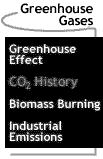

 |
Greenhouse Gases:
CO2 History Could increasing levels of CO2 be causing global warming? Do CO2 levels have anything to do with global temperatures? One way to try to answer questions like these is to look at the past. Scientists can learn about the temperature and the CO2 content in the atmosphere thousands of years ago by drilling into large ice sheets in places such as Antarctica and Greenland. Gas bubbles trapped in the ice have the same composition as the atmosphere at the time they were formed. A graph of the temperature and concentration of CO2 in the atmosphere for the past 160,000 years is shown below.
For example, as glaciers melt they release the CO2 trapped in the air bubbles in the ice. The rising levels of CO2 would provide a positive feedback mechanism to reinforce the global warming. Now, however, the mechanism for increasing CO2 levels has changed. Anthropogenic emissions are at least as great as any natural process for adding greenhouse gases to the atmosphere. Human activity is increasing the level of CO2 at an unprecedented rate. Increases which would normally have occurred over centuries by normal natural processes have been duplicated in less than a century because of human activity. This unnatural rapid increase places an added burden on any natural process which would remove CO2 from the atmosphere to keep the atmosphere in equilibrium. From the graph we also see that CO2 levels in the past have been at least as high as they are now, and Earth's temperature has been as warm as it is now. Note however, that Earth's temperature for most of the last 160,000 years has been substantially colder than it is now. We are indeed fortunate to live on Earth now. The graph shows essentially one glacial cycle. The cycle is marked by a rapid warm up for a period of 10,000 to 20,000 years. This is followed by a long cool down during which the temperature fluctuates but never reaches the high temperatures at the beginning of the cycle. We see that Earth is at the beginning of a glacial cycle, and thus the temperature is expected to be warm. This poses a major problem for scientists. Are the rising temperatures simply a result of Earth coming out of a glacial period? Or is human activity the cause of the rising temperatures? To distinguish one effect from the other, NASA established an ongoing project called the Greenhouse Effect Detection Experiment (GEDEX). Its purpose is to establish some threshold values: if these values are surpassed, we can say that human-caused global warming is definitely occurring.
[ Greenhouse Gases: Greenhouse Effects / [ Home ] [ Teacher Pages ] [ Modules & Activities ] |
HTML code by Chris Kreger
Maintained by ETE Team
Last updated November 10, 2004
Some images © 2004 www.clipart.com
Privacy Statement and Copyright © 1997-2004 by Wheeling Jesuit University/NASA-supported Classroom of the Future. All rights reserved.
Center for Educational Technologies, Circuit Board/Apple graphic logo, and COTF Classroom of the Future logo are registered trademarks of Wheeling Jesuit University.